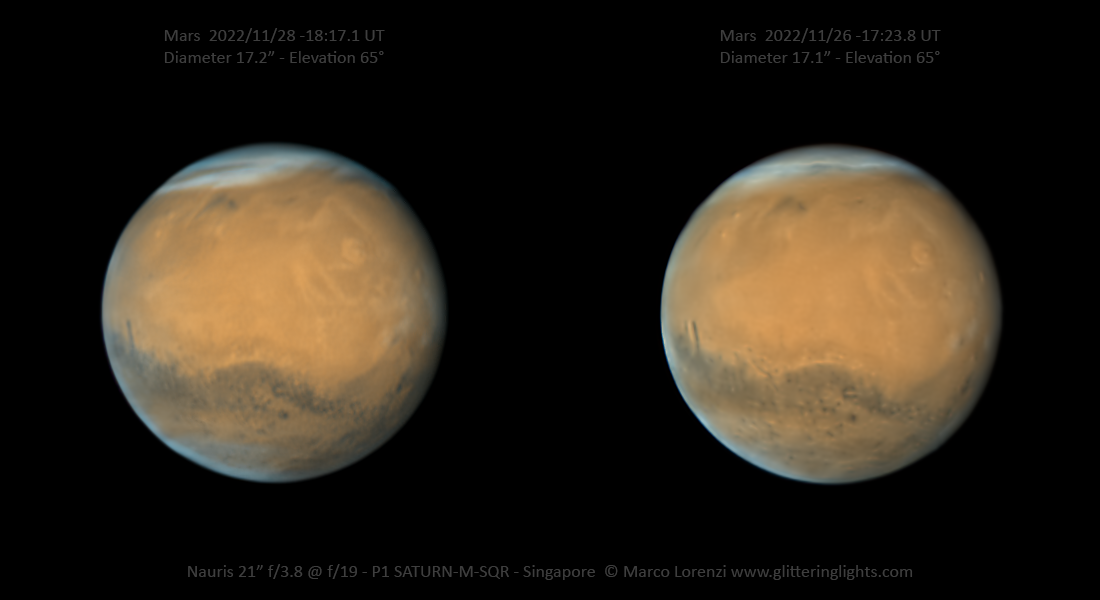03. December 2022
Tī「衝」附近 ê 立體火星

探索宇宙1!逐工會揀一幅無仝款 ê 影像抑是相片,𤆬你熟似咱這个迷人 ê 宇宙,閣有專業天文學者2為你解說3。
- 原始文章:Stereo Mars near Opposition
- 影像來源 kah 版權:Marco Lorenzi
- 台文翻譯:An-Li Tsai (NCU)
[漢羅] Tī「衝」附近 ê 立體火星
這兩粒看起來遮爾清楚 ê 火星是 11 月底 tī 新加坡 ê 厝頂望遠鏡翕–ê。 這个時陣,火星 kah 新加坡 ê 距離是 8200 公里。 伊會 tī 12 月 8 號 行到「衝」ê 相位,就是 tī 地球天頂 kah 太陽相對 ê 位置。 火星倚西爿 ê Olympus 山 是 Tharsis Montes 區上大 ê 火山(嘛是太陽系上大 ê 火山)。 就是 tī 這兩張影像內底 正爿較倚面頂彼个,小可仔較淺色 ê 甜箍麭形彼搭。 中央較暗彼搭是 Sirenum 高地,毋過倚東爿彼个烏烏長長 ê 半島是 Gomer 灣。 半島尾仔遐是 Gale 隕石坑,是 2012 年好奇號探測車 降落 ê 地點。 Gomer 灣頂懸彼寡白點,是 Elysium 區內底 ê 其他火山。 火星上頂懸遐是 北極 ê 極冠,攏去予冰 kah 雲崁牢咧。 這兩張仝一个 火星半球 ê 影像是立體影像 ê 仝一組相片,其中一張是過兩工才翕–ê。 Kā 你 ê 目睭看 tùi 這張相片 ê 中央,兩粒目睭 ê 視線交叉,一直到 kā 兩張分開 ê 影像合做一張,按呢你就有法度看著這粒紅色行星 ê 3D 影像矣。
[POJ] Tī “Chhiong” hù-kīn ê Li̍p-thé Hóe-chhiⁿ
Chit nn̄g lia̍p khòaⁿ–khí-lâi chiah-nī chheng-chhó ê Hóe-chhiⁿ sī 11 goe̍h té tī Sin-ka-pho ê chhù-téng bōng-oán-kiàⁿ hip–ê. Chit ê sî-chūn, Hóe-chhiⁿ kah Sin-ka-pho ê kū-lī sī 8200 kong-lí. I ē tī 12 goe̍h 8 hō kiâⁿ kàu “Chhiong” ê siòng-ūi, to̍h sī tī Tē-kiû thiⁿ-téng kah Thài-iông siong-tùi ê ūi-tì. Hóe-chhiⁿ óa sai-pêng ê Olympus soaⁿ sī Tharsis Montes khu siōng tōa ê hóe-soaⁿ (mā sī Thài-iông-hē siōng tōa ê hóe-soaⁿ). To̍h sī tī chit nn̄g tiuⁿ iáⁿ-siōng lāi-té chiàⁿ-pêng khah óa bīn-téng hit-ê, sió-khóa-á khah chhián-sek ê tiⁿ-kho͘-pháng hêng hit-tah. Tiong-ng khah àm hit-tah sī Sirenum ko-tē, m̄-koh óa tang-pêng hit-ê o͘-o͘ tn̂g-tn̂g ê pòaⁿ-tó sī Gomer oan. Pòaⁿ-tó bóe-á hiah sī Gale ún-se̍k-kheⁿ, sī 2012 nî Hóⁿ-kî-hō thàm-chhek-chhia kàng-lo̍h ê tē-tiám. Gomer oan téng-koân hit-kóa pe̍h-tiám, sī Elysium khu lāi-té ê kî-tha hóe-soaⁿ. Hóe-chhiⁿ siōng téng-koân hiah sī Pak-ke̍k ê ke̍k-koan, lóng khì hō͘ peng kah hûn khàm-tiâu leh. Chit nn̄g tiuⁿ kāng chit-ê Hóe-chhiⁿ pòaⁿ-kiû ê iáⁿ-siōng sī li̍p-thé iáⁿ-siōng ê kāng chi̍t chō͘ siòng-phìⁿ, kî-tiong chi̍t tiuⁿ sī kòe nn̄g kang chiah hi̍p–ê. Kā lí ê ba̍k-chiu khòaⁿ tùi chit tiuⁿ siòng-phìⁿ ê tiong-ng nn̄g lia̍p ba̍k-chiu ê sī-sòaⁿ kau-chhe, it-ti̍t kàu nn̄g tiuⁿ pun-khui ê iáⁿ-siōng ha̍p chòe chi̍t tiuⁿ, án-ni lí to̍h ū-hoat-tō͘ khòaⁿ-tio̍h chit lia̍p âng-sek kiâⁿ-chhiⁿ ê 3D iáⁿ-siōng–ah.
[KIP] Tī “Tshiong” hù-kīn ê Li̍p-thé Hué-tshinn
Tsit nn̄g lia̍p khuànn–khí-lâi tsiah-nī tshing-tshó ê Hué-tshinn sī 11 gue̍h té tī Sin-ka-pho ê tshù-tíng bōng-uán-kiànn hip–ê. Tsit ê sî-tsūn, Hué-tshinn kah Sin-ka-pho ê kū-lī sī 8200 kong-lí. I ē tī 12 gue̍h 8 hō kiânn kàu “Tshiong” ê siòng-uī, to̍h sī tī Tē-kiû thinn-tíng kah Thài-iông siong-tuì ê uī-tì. Hué-tshinn uá sai-pîng ê Olympus suann sī Tharsis Montes khu siōng tuā ê hué-suann (mā sī Thài-iông-hē siōng tuā ê hué-suann). To̍h sī tī tsit nn̄g tiunn iánn-siōng lāi-té tsiànn-pîng khah uá bīn-tíng hit-ê, sió-khuá-á khah tshián-sik ê tinn-khoo-pháng hîng hit-tah. Tiong-ng khah àm hit-tah sī Sirenum ko-tē, m̄-koh uá tang-pîng hit-ê oo-oo tn̂g-tn̂g ê puànn-tó sī Gomer uan. Puànn-tó bué-á hiah sī Gale ún-si̍k-khenn, sī 2012 nî Hónn-kî-hō thàm-tshik-tshia kàng-lo̍h ê tē-tiám. Gomer uan tíng-kuân hit-kuá pe̍h-tiám, sī Elysium khu lāi-té ê kî-tha hué-suann. Hué-tshinn siōng tíng-kuân hiah sī Pak-ki̍k ê ki̍k-kuan, lóng khì hōo ping kah hûn khàm-tiâu leh. Tsit nn̄g tiunn kāng tsit-ê Hué-tshinn puànn-kiû ê iánn-siōng sī li̍p-thé iánn-siōng ê kāng tsi̍t tsōo siòng-phìnn, kî-tiong tsi̍t tiunn sī kuè nn̄g kang tsiah hi̍p–ê. Kā lí ê ba̍k-tsiu khuànn tuì tsit tiunn siòng-phìnn ê tiong-ng nn̄g lia̍p ba̍k-tsiu ê sī-suànn kau-tshe, it-ti̍t kàu nn̄g tiunn pun-khui ê iánn-siōng ha̍p tsuè tsi̍t tiunn, án-ni lí to̍h ū-huat-tōo khuànn-tio̍h tsit lia̍p âng-sik kiânn-tshinn ê 3D iánn-siōng–ah.
[English] Stereo Mars near Opposition
Mars looks sharp in these two rooftop telescope views captured in late November from Singapore, planet Earth. At the time, Mars was about 82 million kilometers from Singapore and approaching its opposition, opposite the Sun in planet Earth’s sky on December 8. Olympus Mons, largest of the volcanoes in the Tharsis Montes region (and largest known volcano in the Solar System), is near Mars’ western limb. In both the images it’s the whitish donut-shape at the upper right. The dark area visible near center is the Terra Sirenum region while the long dark peninsula closest to the planet’s eastern limb is Sinus Gomer. Near its tip is Gale crater, the Curiosity rover’s landing site in 2012. Above Sinus Gomer, white spots are other volcanoes in the Elysium region. At top of the planet is the north polar cap covered with ice and clouds. Taken about two days apart, these images of the same martian hemisphere form a stereo pair. Look at the center of the frame and cross your eyes until the separate images come together to see the Red Planet in 3D.
詞彙學習(漢羅/POJ/KIP/華語/English)
- 【衝】chhiong/tshiong/衝/Opposition
- 【火星】Hóe-chhiⁿ/Hué-tshinn/火星/Mars
- 【好奇號探測車】Hóⁿ-kî-hō/Hónn-kî-hō/好奇號探測車/Curiosity rover
- 【極冠】ke̍k-koan/ki̍k-kuan/極冠/polar cap